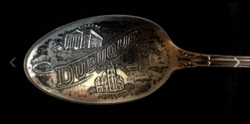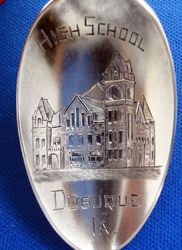Encyclopedia Dubuque
"Encyclopedia Dubuque is the online authority for all things Dubuque, written by the people who know the city best.”
Marshall Cohen—researcher and producer, CNN
Affiliated with the Local History Network of the State Historical Society of Iowa, and the Iowa Museum Association.
SILVER SOUVENIR SPOONS
SILVER SOUVENIR SPOONS. Collecting souvenir spoons has been a popular hobbY since the late 1800s when this European fad swept the nation. Souvenir spoons grew out of the birth of leisure tourism in Europe around the mid 1800s. Wealthy Americans on a tour of Europe brought home these souvenirs marked with the names of cities and some of the famous landmarks they had seen. (1) As with all other metalware, spoons marked as sterling silver are 92.5 percent silver and 7.5 percent copper and other trace elements. This standard originated in England in the 13th century and got the backing of British law in 1300, when Edward I mandated that sterling silver bear a hallmark in order to prevent fraud. (2)
Hundreds of years later, in the 1840s, this standard became increasingly important with the development of electroplating, which required significantly less silver to produce something that looked like solid sterling. Suddenly, spoons and other utensils were mass-produced, with a wider range of silver content than ever before. The sterling-silver standard is still enforced in England today by the Worshipful Company of Goldsmiths. (3)
The first souvenir spoons produced in the United States was produced in 1889 by Galt & Bros of Washington D.C. It featured a profile of George Washington and was created to mark the 100th anniversary of his presidency. It was shortly followed by the Martha Washington spoon. (4)
At the end of 1890, there were only a few patented or in production in America. Around half a year later, hundreds of souvenir spoon patterns were being produced to commemorate American cities and towns, famous people, historical events and significant events of the time. (5)
In 1891 several books on collecting souvenir spoons were published; by the time of the Chicago World Fair in 1893, the "Golden Age" of souvenir spoons had well and truly begun. The 19th century was the age of industrialization with the rapid acceleration of technology and the invention of mass production techniques. The production of souvenir spoons became more efficient and the volume of goods increased. The collapse of the silver market also in 1893 meant silver became affordable to many ordinary Americans for the first time, whilst retaining its image of being for the privileged and wealthy. Over the next 30 years every expo, fair and event was an opportunity to create a souvenir spoon. (6)
---
Source:
1. "The History of Souvenir Spoons," Online: http://www.pbs.org/opb/historydetectives/feature/history-of-souvenir-spoons/
2. "Antique Silver Spoons," Collectors' Weekly. Online: http://www.collectorsweekly.com/silver/spoons
3. Ibid.
4. "The History of Souvenir Spoons..."
5. Ibid.
6. Ibid.



